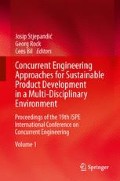Abstract
For critical airline components, design and failure data is not released by the manufacturer, and the maintenance execution of these components is mandated, planned and executed by the manufacturer. This yields maintenance practices identical for all systems within the fleet, independent of the historical usage of the operator. And since the design spectrum is not validated towards the actual usage spectrum, this will result in too early replacements of components which in turn increase life-cycle maintenance costs and reduce overall availability. In this research, a usage severity driven maintenance framework is proposed, which zooms in at the actual failure mechanisms applied on the component and then calculates its service live based on the loads acting on the component under several circumstances. For the Chinook T-55 engine, this maintenance strategy reduces life-cycle maintenance costs with 20 % while availability has increased.
Access this chapter
Tax calculation will be finalised at checkout
Purchases are for personal use only
Preview
Unable to display preview. Download preview PDF.
References
1. Kumar UD (2000) Reliability, Maintenance and Logistic support: A life cycle approach. Kluwer Academic Publishers, Dordrecht.
2. Tinga T (2010) Applications of Physical Failure Models to Enable Usage and Load Based Maintenance. Reliability Engineering and System Safety. 1061-1075.
3. Melchers R (1999) Structural reliability: analysis and prediction. John Wiley and Sons, New York.
4. Li C (1995) Computation of the Failure Probability of Deteriorating Structural Systems. Computers and Structures. 56:1073-1079.
5. Esary JD, Ziehms H (1975) Reliability of Phased Mission: Reliability and Fault-Tree Analysis. Society for Industrial Applied Mathematics. 213-236.
6. Chew SP, Dunnett SJ, Andrews JD (2008) Phased Mission Modeling of Systems with Maintenance-free Operating Periods Using Simulated Petri Nets. Microelectronics Reliability. 1293-1298.
7. Clarotti CA, Contini S, Somma R (1980) Repairable Multiphase Systems: Markov and Fault-Tree Approaches for Reliability Evaluation. Apostolakis G. 94:45-58.
8. Jardine AKS, Lin D, Banjevic D (2006) A Review on Machinery Diagnostics and Prognostic Implementing Condition-Based Monitoring. Mechanical Systems and Signal Processing. 1483-1510.
9. Wang W (2010) A Model to Determine the Optimal Critical Level and the Monitoring Intervals in Condition-Based Maintenance. International Journal of Production Research. 1425-1436.
10. Curran R, Abu-Kian T, Repko MJF et al. (2010) A Value Operations Methodology for Value Driven Design: Medium Range Passenger Airliner Validation. In: Proceedings of AIAA Annual Society Meeting.
11. Saaty TL (2003) How to Make a Decision: The Analytical Hierarchy Process. European Journal of Operations Research. 48:9-26.
12. Adamides ED, Stamboulis YA, Varelis AG (2004) Model-Based Assessment of Military Aircraft Engine Maintenance Systems. Journal of Operations Research Society. 957-967.
13. Banks JC, Reichard KM, Hines JA et al. (2010) Platform Degrader Analysis for the Design and Development of Vehicle Health Management Systems. The Journal of the Reliability Information Analysis Center. 18-21.
14. Palmgren AG (1924) Die Lebensdauer von Kugellagern. Zeitschrift des Vereines Deutscher Ingenieure, 68: 339–341.
15. ASTM (1999) Standard Practices for Cycle Counting in Fatigue Analysis. Techncial Report ASTM E 1049-85.
16. Franke L, Dierkes G (1999) A Non-Linear Fatigue Damage Rule with an Exponent Based on a Crack Growth Boundary Condition. International Journal of Fatigue. 21:761-767.
17. Sonsino CM (2007) Course of SN-curves Especially in the High-Cycle Fatigue Regime with Regard to Component Design and Safety. International Journal of Fatigue. 29:2246-2258.
18. Robinson EL (1952) Effect of Temperature Variation on the Long-Time Rupture Strength of Steels. Trans ASME. 74:777-781.
19. Lewis EE (1994) Introduction to Reliability Engineering. John Wiley and Sons, New York.
20. Kaplan EL. Meier P (1958) Nonparametric estimation from incomplete observations. J. Amer. Statist. Assn. 53:457-481.
21. Montgomery JE, Clark JM (1962) Dust Erosion Parameters for a Gas Turbine. In: SAE Summer Meeting.
Author information
Authors and Affiliations
Corresponding author
Editor information
Editors and Affiliations
Rights and permissions
Copyright information
© 2013 Springer-Verlag London
About this paper
Cite this paper
Stuivenberg, T., Ghobbar, A.A., Tinga, T., Curran, R. (2013). Towards a Usage Driven Maintenance Concept: Improving Maintenance Value. In: Stjepandić, J., Rock, G., Bil, C. (eds) Concurrent Engineering Approaches for Sustainable Product Development in a Multi-Disciplinary Environment. Springer, London. https://doi.org/10.1007/978-1-4471-4426-7_31
Download citation
DOI: https://doi.org/10.1007/978-1-4471-4426-7_31
Published:
Publisher Name: Springer, London
Print ISBN: 978-1-4471-4425-0
Online ISBN: 978-1-4471-4426-7
eBook Packages: EngineeringEngineering (R0)

